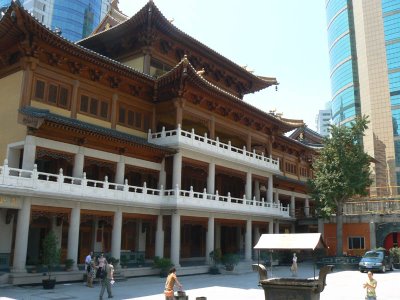
But I don't want to exaggerate the effect. It's really more an ancient temple site than an ancient temple: the temple burnt down a century ago, and what was re-built was supposedly heavily damaged in the early Communist era. What exists now is a modern re-construction, one that uses far too much concrete. Something about it seems so 1970s to me. Maybe it's merely the shade of the wood used, or perhaps the way the exaggerated lacquering giving a plastic-wood look to the whole affair. The plain wooden ceiling panels are a whole lot more attractive than the carved lions:

On the other hand there's some more interesting sculptures on the roof. They almost seem whimsical. "Why elephants?" I ask people. I guess it's the connection of Buddhism being from India and India having lots of elephants, and people guess that I'm right, but nobody's 100%, and I've seen a whole lot of Buddhist temples without an elephant motif to the roof.

There aren't so many Buddhist temples in Shanghai, and the ones that do exist are only popular during times of Buddhist celebrations. I went on a weekday and only a few women were praying:
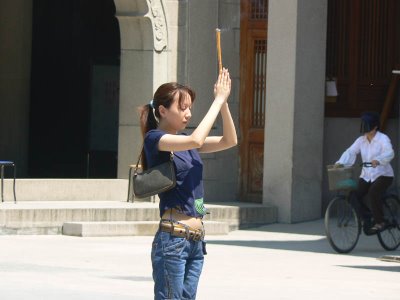
 There are many wildly different schools of Buddhism, in America the most famous ones are the versions emphasizing meditation, self-study, and enlightenment. However, with Han Chinese, supposedly Buddhism is pretty homogenous. It emphasizes the ability of mystical beings to bring people's souls to a better world, and is somewhat analagous to Christianity - it's a style of Buddhism common to the other Northeast Asian nations. One of the exceptions to the analogy is a strong element of exoticism, with monks wearing colorful robes, and temples decorated by intricate artworks. It's very Indian-influenced, and Buddhism is not percieved as a native religion. For instance you will never see a Han Chinese who looks like this:
There are many wildly different schools of Buddhism, in America the most famous ones are the versions emphasizing meditation, self-study, and enlightenment. However, with Han Chinese, supposedly Buddhism is pretty homogenous. It emphasizes the ability of mystical beings to bring people's souls to a better world, and is somewhat analagous to Christianity - it's a style of Buddhism common to the other Northeast Asian nations. One of the exceptions to the analogy is a strong element of exoticism, with monks wearing colorful robes, and temples decorated by intricate artworks. It's very Indian-influenced, and Buddhism is not percieved as a native religion. For instance you will never see a Han Chinese who looks like this: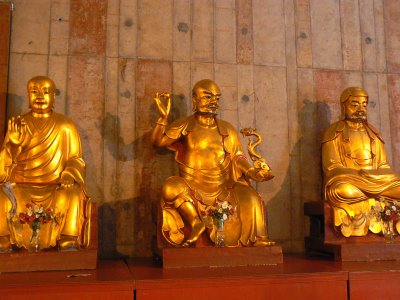
Appealing to the god for salvation is big in this form of Buddhism. A good way to do this is with incense.

Personally I don't care for the smell but maybe that has something to do with not yet having achieved god-head. The incense sticks are sold on the honor system, which I must admit I couldn't even imagine elsewhere in Shanghai. It's twenty five cents a stick.
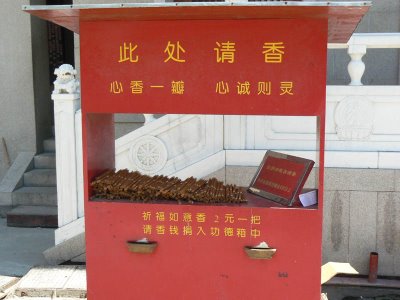
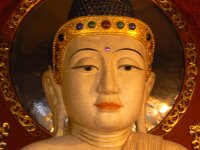 Around the grounds are scattered different Buddhas - this form of Buddhism doesn't just believe in the historical Buddha, but a range of real Buddhas, mystical Buddhas, demons, Buddhas who put off their salvation to help others, etc. They're assigned various mystical powers, and depending on the mystical power you're particularly sympathetic to, you pray there. Some of the different Buddhas have offerings of fruits and flowers at their feet, put there by the priests.
Around the grounds are scattered different Buddhas - this form of Buddhism doesn't just believe in the historical Buddha, but a range of real Buddhas, mystical Buddhas, demons, Buddhas who put off their salvation to help others, etc. They're assigned various mystical powers, and depending on the mystical power you're particularly sympathetic to, you pray there. Some of the different Buddhas have offerings of fruits and flowers at their feet, put there by the priests.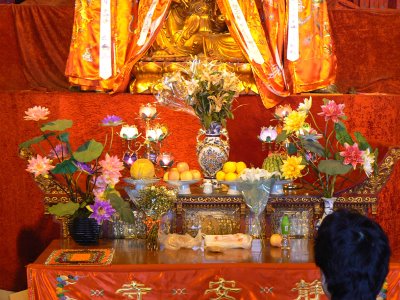
Perhaps it's all good for the soul, and I guess I'll have a chance to find out, as I'm moving about a minute away from the temple. While I'll miss living towards the outskirts of Shanghai, and the chance to see live chickens killed near my front door and then hanged up to dry on the clothesline, I'm also really looking forward to living in a more crowded area with more people and places to see.
No comments:
Post a Comment